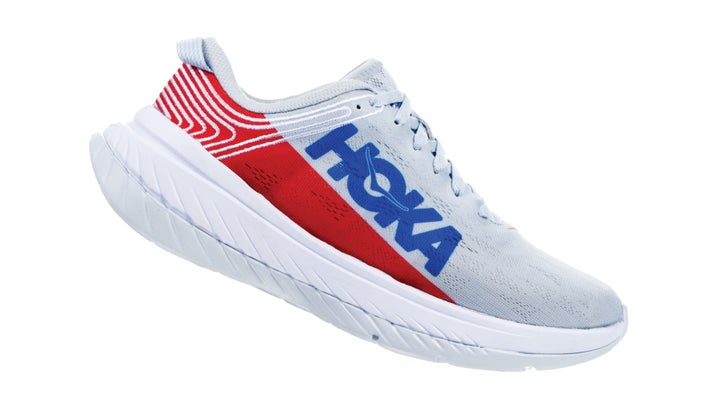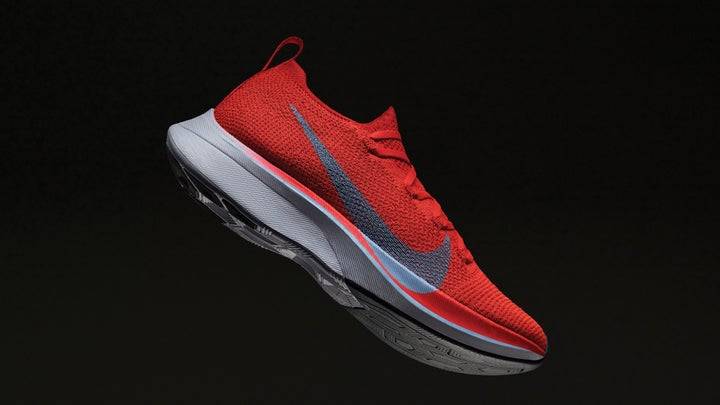New perk! Get after it with local recommendations just for you. Discover nearby events, routes out your door, and hidden gems when you sign up for the Local Running Drop.
Biomechanists at HOKA and Nike have been tinkering away, and triathletes get to reap the benefits. We pit two brands’ stride-enhancing carbon-plated running shoes head to head to find their differences.
Carbon-Plated Running Shoe Face Off: Hoka Carbon X
$180, Roadrunnersports.com, 7.2oz (women), 8.5oz (men)

What
Adding to its classic oversized rocker-styled shoe, HOKA incorporated a full-length carbon plate that acts as a springboard, absorbing impact from rear-, mid-, or forefoot-strike and fluidly transferring it through the gait cycle to a snappy-yet-stable toe off. This works especially well at a higher cadence. The 1.5mm carbon plate is sandwiched above an injected rubberized EVA (read: stiffer) and below a softer foam.
Pros
The complete package of carbon-plated running shoe race-day performance with stability and cushioning makes the Carbon X an ideal shoe for off-the-bike half and full marathons, where comfort is required. The maximalist stability platform helps to elevate an Ironman shuffle to a livelier stride, even with trashed legs. The compression of the softer foam and resilience of the carbon plate translates to less contact time and a quicker transition with less depression into the midsole.
Cons
Bring a shoe horn to T2 because getting your foot into the Carbon X is tricky due to a flexible—and Achilles tendon friendly—single-layered engineered mesh rear upper. The lacing is a little wonky and you may want a lace lock, as these tend to come untied. The weight is on the heavier side for races shorter than a half Ironman and with no outsole, the Carbon X is not intended for much more than 300 miles of racing.
This Carbon-Plated Running Shoe Is For
Off-the-bike racing with efficient comfort.
Carbon-Plated Running Shoe Face Off: Nike Zoom Vaporfly 4% Flyknit
$250, Roadrunnersports.com, 6.7oz unisex

What
A carbon-plated running shoe that dominates major marathons with its energy-returning ZoomX foam and a rigid, curved carbon-fiber plate that delivers enough improved running economy. It has become the go-to shoe for a tremendous number of elite runners who aren’t sponsored by Nike competitors. (Note: Nike has also released the NEXT%, an update to the Vaporfly 4% with added midsole foam in the midfoot for greater impact protection. It is not yet available for testing.)
Pros
Arguably the fastest shoe on the market, the Vaporfly 4%’s heel-to-toe carbon-fiber plate has shown its efficiency gains through the propulsive sensation that coaxes users to a faster clip.
Cons
The Vaporfly 4% works best for neutral, efficient forefoot runners who are able to hold down a high turnover, staying up on their toes. It is not very stable for heel strikers. As such, it caters to elites, especially those who are racing on fresh legs. In other words: very few triathletes, unless they are using the 4% for speed work or a running race, but not a tri. They are wired for speed but not very forgiving to those who aren’t able to harness the shoe’s energy return because their legs are toast. The Next% may, however, address some of those concerns, as it features added midsole foam, a lower heel-toe offset, and off-the-instep lacing. It also boasts Achilles relief, a new breathable yet water-repelling woven upper inspired by sailcloth, and better outsole traction for wet streets.
This Carbon-Plated Running Shoe Is For
A pure all-out marathoner or half-marathoner with fresh legs.
Carbon-Plated Running Shoes Winner
The Next% may be tri friendlier than the 4%, but the Carbon X delivers what triathletes need—at almost $100 less.